What are composites?
Composites are basically heterogeneous materials, constituted by the mixture of two or more materials (or composites) with different properties, and giving the new composite material its own properties.
The composite material is intended to work as if it were a homogeneous (isotropic) material which retains its properties in all axes and not as a heterogeneous (anisotropic) material which has different properties according to each direction within the material. The properties of a composite material are the result of the properties of its constituents in the proportion that each one is in.
Composite engineering tries to control the behavior of the composite through the design of proportions and characteristics of its constituents.
History
We always associate composites with resins and glass or carbon fibers, which began in the first half of the 20th century for military components and has evolved to a very wide variety of materials, fibers and applications. However, composites began in architecture more than 4000 years ago with the mixture of straw and mud: adobe.
Later on, the concrete  (Agrippa Pantheon in Rome) appears, about 2000 years old, which was also a composite based on volcanic ash and limestone.
(Agrippa Pantheon in Rome) appears, about 2000 years old, which was also a composite based on volcanic ash and limestone.
In nature there are also composites. A bamboo stem or our own bones are an example.
How many types of composite are there?
There are basically four types of composites:
- Matrices (resins, ceramics, metals, concrete, etc.), reinforced with fibers (carbon, boron, glass, metal, ceramics, etc.)
- Matrices (resins, ceramics, metals, etc.), reinforced with flakes
- Matrices (resins, ceramics, metals, concrete, etc.), reinforced with particles (concrete is one of them)
- Laminates made with other laminates, even of different materials (Commonly called sandwich)
What uses do composites have and why are they being used more and more?
Composites are used in airplanes, ships, cars, buildings, laminated glass and even in our teeth when they are fixed by the dentist.
The challenges are increasing in technology and natural materials alone are not enough. We could dare to say that from now on, the materials will all be composites.
When should you use them and their advantages?
It is important to know that a composite material is more expensive than a natural one and is not always used to reduce costs. It is used because there is no other remedy. If airplanes could be made of steel or concrete, they would be, because they are cheap materials. But they cannot be made except in light and resistant materials. And like this there are many examples (although not all). Sometimes ordinary materials, especially in construction, cannot be replaced by composites.
It is no longer as easy to choose materials in engineering as it used to be and if we follow conventional principles, we can choose the least suitable or try to compete in a segment that is not suitable.
It is convenient to use graphs like this one (Cambridge University) in which the material is chosen in its relation modulus of elasticity versus weight. In this graph, for example, it can be seen that in relation to its Young’s modulus / weight, reinforced carbon fiber (CFRP) and technical ceramics are the most competitive. If the weight and Young’s modulus are very important in what we are developing, CFRP could be the best option.
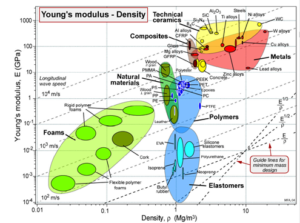
What are the types of composites used in architecture and why?
The most widely used composites in architecture are granular (reinforced concrete), fiber-reinforced (including fabric structures) and laminates (sandwich).
In architecture, resistance is important, but deformation is even more so. In airplanes and cars, it is the opposite. Weight is important but not as important as in the case of airplanes and cars. But there is a rather important point: the possibility of having larger elements without joints (the latter is highly valued by architects).
On the other hand, in construction, prefabricated elements save time, money and work accidents. Composites are prefabricated and easily installed.
In the next images it can be seen the important point achieved in each project when using composites:
- Composite materials allow very large, light and highly resistant elements in buildings (GFRP):

Basra Sports Stadium – Iraq BFG International
- Composite materials allow to imitate natural materials (as stone) with great strength and low weight and space (GFRP):

METRO SHELTERS – Doha BFG International
- In large interior works, composites such as this false ceiling are good (GFRP). They are lighter and safer than convetional ones such as plaster:
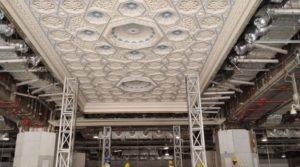
METRO SHELTERS – Doha BFG International
- Complex shapes can be used, resisting earthquakes and wind and with little weight (GFRP). Do this façade in other material is quite difficult

ROSEWOOD – Doha GULF GRC
- Large surfaces without joints and thermal expansion close to zero,can be achieved with the mixture of different types of fibers and the appropriate resin. (GFRP and other fibers).
In this building there are not joint and thermal expansion is solved:

Stedelijk museum– Amsterdam Holland Composites
- High-rise sunshades can be easily incorporated (GFRP). In other material these shapes are not easy to achieve.

KUWAIT INTERNATIONAL TENNIS COURT BFG International
- Lightweight sunshades built into the curtain wall (GFRP). Curtain wall carries the weight and it is important to use resistant and light materials:

SABIC – Saudi Arabia BFG International
- Complex and lightweight shapes in domes(GRP). Again, make these cones inside the dome in other material could be quite difficult:
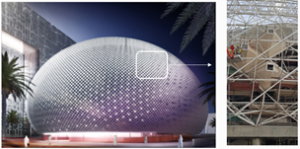
KUWAIT UNIVERITY – Kuwait BFG International
- Complex and daring canopies. These organic shapes and textures achieved in this canopy have to be molded (GRP):
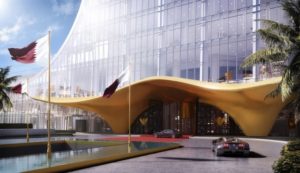
KATARA HOTEL – Doha
Gulf GRC
- Large bays without columns. Metal can be used in this case, but rounded shapes like these, is easy to make in molded elements (GRP):

Haramain High Speed Rail Station (HHR) – King Abdullah Economic City KSA BFG – International
- Biggest canopy made with reinforced graphene. No joints:
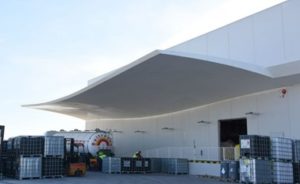
Gazechim Composites Ibérica – Graphenano Composites
How are they connected to the building?
Connections to the building do not differ from those used in any cladding, roof or curtain wall.
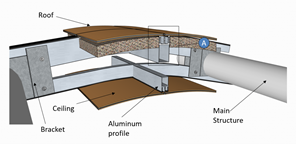
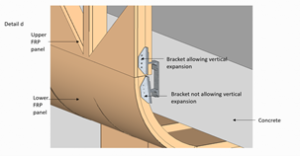
In this regard, the designers have to prevent thermal expansion and tolerances as if they would be using aluminum, ceramic, etc.
Other composites in architecture
- Glass Fiber Reinforced concrete (GFRC)
Glass fiber Reinforced Concrete or GFRC, is a composite comprising cement, fine aggregate, water, chemical admixtures and alkali resistant glass fibers.
The glass fibers reinforce the concrete, much as steel reinforcing does in conventional concrete.
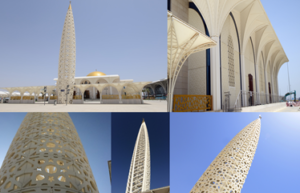
Source: BFG Advanced facades
Ultra-high-performance concrete (UHPC)
The basic raw materials of UHPC are familiar to everyone who knows concrete: water, sand, cement, silica fume, metakaolin and super plasticizers. However, UHPC is an order of magnitude different from traditional categories of concrete.
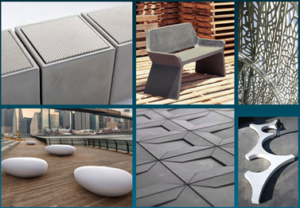
Any other use in construction, other than architecture?
Composites are widely used in civil engineering. For instance, repairing damaged concrete or steel structures.
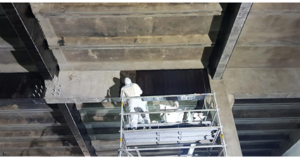
Pipe reinforcement
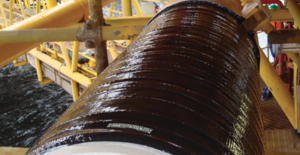
Composites rebar for concrete
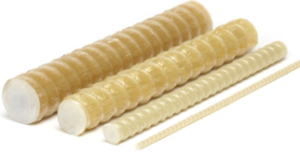
Conclusions
Composite materials are not exactly the materials of the future as something special. They are becoming simply, being the available materials in engineering.


